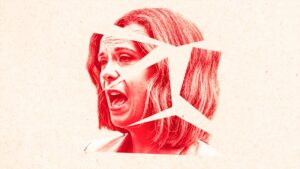
In the midst of a sweltering Californian summer, Dallas Humber’s discontent was palpable. She had knowledge of an Australian individual allegedly prepared to commit a mass casualty attack, yet the plan never materialized. “It pained us all to see what happened in Australia the other day,” the American woman wrote, describing the man as a “would-be saint” in a rallying call to her Neo-Nazi followers to incite violence.
Just days before this message, Australian authorities arrested a man on terror-related charges. It soon became apparent that he was allegedly linked to Humber’s far-right terrorist organization, Terrorgram. While the extent of his involvement remains to be detailed in court, the incident underscores a broader trend: Australian Neo-Nazis drawing inspiration from overseas groups, some of which have been designated as terrorist organizations in Australia.
International Connections and Domestic Implications
An investigation by the Australian Broadcasting Corporation (ABC) has revealed direct interactions between Australian white supremacist groups and their international counterparts. These interactions include discussions aimed at replicating the structures and activities of overseas extremist organizations. Despite this, no Australian-based far-right group has been officially sanctioned.
This development follows the efforts of the National Socialist Network (NSN), Australia’s largest Neo-Nazi group, to establish itself as a political entity representing fringe views on race, identity, and immigration. Recently, NSN members participated in several anti-immigration rallies across Australia, with some accused of violence at a Melbourne event, where they allegedly attacked a First Nations protest camp, injuring four people.
Calls for Action and Regulatory Challenges
In the aftermath of these rallies, several multicultural organizations have called for the NSN to be banned. Australia’s Race Discrimination Commissioner, Giridharan Sivaraman, stopped short of endorsing a ban but emphasized the threat posed by Australian Neo-Nazis to social cohesion and the necessity for better regulation of social media platforms.
“These groups are inherently racist, their beliefs are fundamentally racist, they believe in white supremacy,” Mr. Sivaraman stated. “Any such group is going to threaten the fabric of a society.”
He further highlighted the role of social media in facilitating global influence, allowing hate to spread unchecked.
The Legacy of Iron March and the Rise of New Groups
The NSN, led by Thomas Sewell and Jacob Hersant, traces its roots to several far-right extremist groups, including the now-defunct Neo-Nazi website Iron March. This platform was instrumental in the formation of groups like the National Socialist Order and the Sonnenkrieg Division, both banned in Australia since 2021.
In 2019, a large cache of leaked private messages from Iron March users was published online, providing insights into how Australian Neo-Nazis established connections and drew inspiration from their overseas counterparts. These connections laid the groundwork for Australia’s modern Neo-Nazi movement, including the creation of the Melbourne-based Antipodean Resistance, whose early members included a young Hersant.
“We were inspired heavily by National Action,” an Antipodean Resistance member admitted on Iron March.
The UK government described National Action as “virulently racist, antisemitic and homophobic” before banning it in 2016. The group’s members were known for their black attire, marches, and prejudiced propaganda, actions emulated by Australian groups.
Recruitment and Notoriety: The Far-Right Playbook
Australian far-right groups have focused on propaganda with two primary objectives: recruitment and notoriety. Kristy Campion, a terrorism expert at Charles Sturt University, explains that these strategies aim to drive recruitment and create a facade of legitimacy.
“This goes towards their strategy of achieving some form of legitimacy,” Dr. Campion says. “I don’t think what we’re currently seeing from the Australian extreme right is in any way original or unique.”
Dr. Campion notes that these groups follow a well-established path, albeit with a local twist. In private chats, Australian members of Antipodean Resistance have boasted about media coverage, expressing a desire to provoke outrage and gain television exposure.
Future Risks and the Role of Law Enforcement
In the years since Iron March’s closure, Australian far-right members have formed and dissolved various groups, culminating in the establishment of the NSN and the European Australian Movement. These organizations have become more structured, with the NSN serving as the hardline political wing responsible for activism, including graffiti and flash demonstrations.
The recent anti-immigration marches have intensified scrutiny on these groups. Two days after an alleged attack on a First Nations camp, Sewell disrupted a press conference with Victorian Premier Jacinta Allan. He was later charged with 25 offenses related to the attack and denied bail.
Community Concerns and Government Response
The events have sparked debate over how authorities should address far-right groups. Erin Chew from the Asian Australian Alliance reported racial abuse during the Melbourne march, calling for the NSN to be banned.
“Their aim is to terrorize people that don’t agree with them and do not look like them,” Ms. Chew said.
The Department of Home Affairs and Victoria Police have stated they are monitoring groups that may pose a threat to Australians, but specific investigations remain confidential.
John Roose, an extremism expert at Deakin University, highlighted the challenge of addressing groups that operate at the edge of legality. He warned that the greatest threat comes from individuals on the fringes who may resort to violence inspired by these groups.
“People at the margins who might not necessarily be members of the groups but draw direct inspiration from them are often more likely to employ extremist violence and terrorism,” Dr. Roose said.
The Australian Security Intelligence Organisation (ASIO) expects nationalist and racist violent extremists to continue their efforts to mainstream and expand their movement. Director-General Mike Burgess noted in his annual threat assessment that while these activities will test legal boundaries, the greatest threat of violence comes from lone actors.
As Australia grapples with the rise of domestic extremism, the challenge remains to balance freedom of expression with the need to protect public safety and social cohesion.





